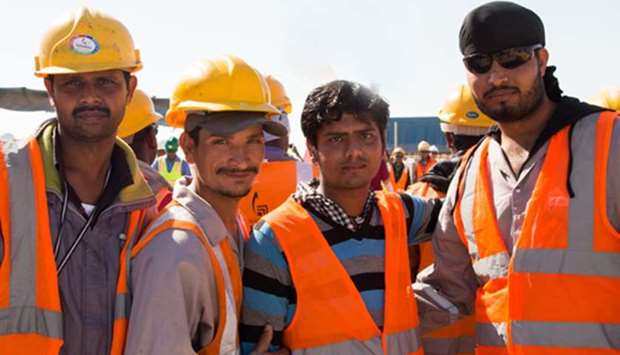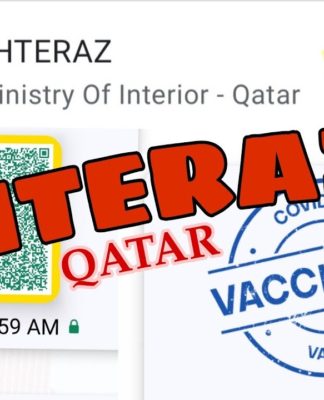Step to preserve safety and health of workers
The Ministry of Public Health (MoPH) and Ministry of Administrative Development, Labour and Social Affairs (MADLSA) have issued Qatar’s Occupational Safety and Health (OSH) Policy to preserve the safety and health of workers in accordance with the national strategy in this regard.
The Ministry of Public Health (MoPH) and Ministry of Administrative Development, Labour and Social Affairs (MADLSA) have issued Qatar’s Occupational Safety and Health (OSH) Policy to preserve the safety and health of workers in accordance with the national strategy in this regard.
“Based on Qatar’s commitment to upholding workers’ health and safety and the efforts it continues to exert to improve its occupational safety and health system, this policy sets out the universal principles concerning OSH endorsed by the Ministry of Administrative Development, Labour and Social Affairs and Ministry of Public Health of Qatar,” according to a policy document released yesterday.
In drafting this policy, the ministries have considered the International Labour Organisation (ILO) Occupational Safety and Health Convention (No 155), 1981, the Protocol of 2002 to the Occupational Safety and Health Convention, 1981, and the Promotional Framework for Occupational Safety and Health Convention, 2006 (No 187), as well as their accompanying recommendations.
The situation regarding OSH and the working environment will be reviewed by representatives of both ministries at appropriate intervals, or if necessary with a view to evaluating results, identifying major problems and establishing priorities of action.
The policy aims to promote the protection of workers’ health and prevent accidents, injuries and illnesses arising out of, linked with or occurring in the course of work, by eliminating or minimising the causes of hazards inherent in the working environment.
It also aims to enhance the provision of quality occupational health and safety services at the national level.
The policy covers all employers and workers in all sectors of the economy and all forms of the employment relationship.
The guiding principles and actions enunciated in the policy are deemed to be instrumental to its implementation.
The following principles are recognised as guiding the action on OSH at the national level:
In drafting this policy, the ministries have considered the International Labour Organisation (ILO) Occupational Safety and Health Convention (No 155), 1981, the Protocol of 2002 to the Occupational Safety and Health Convention, 1981, and the Promotional Framework for Occupational Safety and Health Convention, 2006 (No 187), as well as their accompanying recommendations.
The situation regarding OSH and the working environment will be reviewed by representatives of both ministries at appropriate intervals, or if necessary with a view to evaluating results, identifying major problems and establishing priorities of action.
The policy aims to promote the protection of workers’ health and prevent accidents, injuries and illnesses arising out of, linked with or occurring in the course of work, by eliminating or minimising the causes of hazards inherent in the working environment.
It also aims to enhance the provision of quality occupational health and safety services at the national level.
The policy covers all employers and workers in all sectors of the economy and all forms of the employment relationship.
The guiding principles and actions enunciated in the policy are deemed to be instrumental to its implementation.
The following principles are recognised as guiding the action on OSH at the national level:
* Key focus on the principle of prevention.* Continuous improvement through the assessment of occupational risks and control of hazards at source for addressing issues arising from a constantly changing world of work.* Development of a nationwide preventative safety and health culture by raising public awareness; providing training to workers and employers on OSH; and taking measures to ensure that workers are informed of safety and health hazards associated with their work.* The right to a safe and healthy working environment, through the establishment of a system of defined rights, responsibilities and duties.
The areas of action comprise all activities – at any level in the national context – which will be further elaborated in the OSH National Strategy and undertaken to ensure prevention of accidents, injuries and illnesses at work. These are as follows:
A. Co-ordination, co-operation and consultation mechanisms to ensure dialogue and exchange of best practices between the different authorities with responsibilities for OSH at the various levels in the national OSH system, including joint activities for dissemination of information, prevention, promotion and protection.B. Development of systems for identification, recording, notification, compilation, analysis and annual publication of statistics on occupational accidents (including injuries and fatalities) and diseases to foster transparency and facilitate the exchange of OSH statistics and data among relevant authorities; and to measure progress and the effectiveness of OSH systems.C. Harmonisation, regular update and communication of the OSH legislation and standards.D. Provision of occupational health services entrusted with essentially preventive functions, responsible for advising employers and workers in the undertaking on the requirements for the establishment and maintenance of a safe and healthy working environment. The services facilitate the adaptation of work to the capabilities of workers in the light of their state of physical, social and mental health and wellbeing.E. Broaden access to OSH education and training both at the national level and in the workplace, including the integration of OSH at all levels, to ensure that training, capacity building and raising awareness activities include all relevant stakeholders.The MADLSA and MoPH are responsible for the implementation of the National Policy on OSH, without prejudice to the participation of other organs and institutions that work on OSH.
Following are the MADLSA’s responsibilities:
A. To elaborate, review and revise the labour legislation and regulations on OSH, in collaboration with relevant stakeholders.B. To elaborate and review periodically the national policy concerning the action of labour inspection services, and to supervise and co-ordinate labour inspection activities.C. To participate in the development and implementation of special programmes for OSH, including specific studies and research.D. To promote compliance, at the national level, with the agreements and conventions ratified by Qatar together with international organisations, in particular the ILO, in the areas of its competence.E. To collect, analyse, share information and report on data concerning occupational accidents and diseases.F. To develop and implement educational actions on topics related to the improvement of working conditions in health, safety and environmental aspects of work.G. To disseminate information that contributes to the protection and promotion of workers’ health and safety.H. To conduct investigations to identify the causes of accidents and diseases in the workplace, in collaboration with relevant stakeholders.I. To establish partnerships and technical exchanges with related national and international organisations and institutions to strengthen institutional performance, and train public officials.J. To foster the availability and training of human resources devoted to occupational safety and health.
Following are the responsibilities of the MoPH (including all health facilities under the ministry):
A. To promote a healthy working environment, prevention of work-related injuries and diseases, protection from health hazards.B. To promote integrated health care services for workers and provision of comprehensive physical and psycho-social services, including rehabilitation, and strengthening occupational health surveillance.C. To define standards and indicators for the follow-up of activities concerning workers’ health.D. To collect, analyse, share information and report on data concerning occupational accidents and diseases.E. To conduct periodic review and update the official list of work-related diseases, contained in table No 1 of the Labour Law (Law No 14 of 2004); and table No 3 of the HR law (Law No 15 of 2016).F. To contribute to the dissemination of information on health services available to workers.G. To support the development of studies and research on workers’ health, and dissemination of the findings.H. To foster the availability and training of human resources for health devoted to occupational safety and health.

























